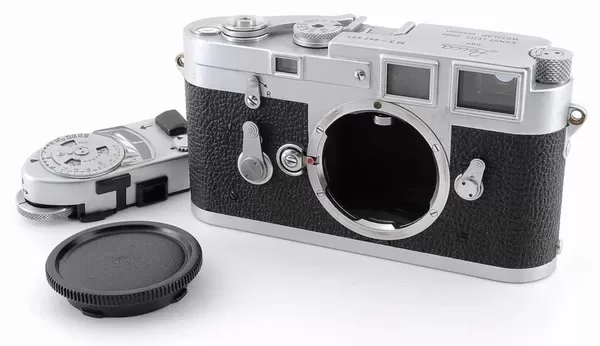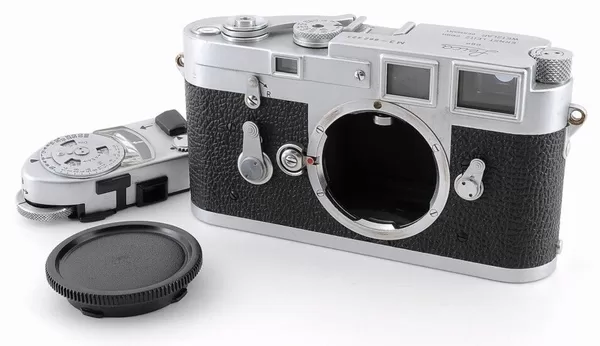The Leica M3 is a legendary 35mm film rangefinder camera produced by the German company Leica Camera AG. Building on the success of the Leica I, introduced in 1925, the Leice M3 was introduced in 1954 and it quickly became an iconic camera in the world of photography. The “M” in its name stands for “Messsucher,” which is the German word for rangefinder.
Here are some key features and characteristics of the Leica M3:
Rangefinder System: The Leica M3 is a rangefinder camera, which means it uses a separate window to focus the lens. Photographers align two superimposed images in the viewfinder to achieve precise focus.
Interchangeable Lenses: It features an M-mount lens system, allowing users to attach a wide variety of Leica lenses, providing versatility in capturing different types of shots.
Purely Mechanical: Unlike many modern cameras that rely on electronics and batteries, the Leica M3 is purely mechanical. It operates without batteries and is known for its robust and durable construction.
Viewfinder with Frame Lines: The camera’s viewfinder features bright and accurate frame lines that automatically adjust according to the lens attached. This makes composition and framing more convenient.
Quiet Operation: The Leica M3 has a quiet shutter mechanism and film advance lever, making it suitable for discreet and unobtrusive photography, especially in street photography.
Superb Build Quality: The camera is renowned for its exceptional craftsmanship and build quality. It’s often considered one of the best-built cameras in history.
Timeless Design: The Leica M3 features a minimalist, iconic design that remains highly regarded among photographers and camera enthusiasts. Its design has inspired countless other camera manufacturers.
Film Format: It uses standard 35mm film, which is widely available, allowing photographers to capture high-quality images on film.
Manual Controls: The camera provides full manual control over settings like shutter speed, aperture, and focus, giving photographers complete creative control over their shots.
The Leica M3 gained a reputation for its exceptional image quality, ease of use, and reliability. It was widely used by both amateur and professional photographers, including many famous photographers who produced iconic images with it. Even though digital photography has largely replaced film, the Leica M3 continues to be highly sought after by collectors and photographers who appreciate its timeless design and the unique qualities of film photography.
The most sought after Leica SLR after the Leicaflex SL2 is the R6.2, the most reliable of the R series. The shutter is mechanical so batteries are only used for the light meter.
The Leica M3 is a legendary camera that has been used by numerous famous photographers over the years. Here are a few notable photographers who have used the Leica M3:
Henri Cartier-Bresson: Perhaps the most famous Leica M3 user, Cartier-Bresson was a pioneer of modern street photography and a master of the decisive moment. His iconic black and white images were often captured with a Leica M3.
Elliott Erwitt: Known for his witty and humorous photography, Erwitt is another renowned photographer who used the Leica M3 extensively throughout his career.
Don McCullin: A British photojournalist famous for his powerful and often harrowing war photography, McCullin used the Leica M3 during his early years as a photographer.
Ernst Haas: Haas was a pioneer in color photography and a master of light and color. He used the Leica M3 to create some of his groundbreaking color images.
Garry Winogrand: A prominent street photographer and one of the most prolific photographers of the 20th century, Winogrand was known for capturing the energy and chaos of everyday life in America. He frequently used the Leica M3.
Robert Frank: The Swiss-American photographer is best known for his groundbreaking book “The Americans,” which documented the United States in the 1950s. Many of the images in this book were taken with a Leica M3.
Saul Leiter: Known for his pioneering color street photography in New York City, Leiter was another Leica M3 enthusiast who captured the city’s essence in a unique and artistic way.
Rene Burri: A Swiss photographer famous for his portraits of Che Guevara and his work for Magnum Photos, Burri used the Leica M3 for many of his assignments.


These photographers, among others, have demonstrated the versatility and capabilities of the Leica M3 through their iconic and influential work.
The camera’s compact design, precise mechanics, and superb optics made it a favorite tool for capturing moments of history and everyday life.
Buyer’s Guide for the Leica M3 Camera
If you’re a photography enthusiast or a professional looking for a timeless and iconic film camera, the Leica M3 is a classic choice that has stood the test of time. First introduced in 1954, the Leica M3 has maintained its reputation as one of the finest 35mm film cameras ever produced. In this buyer’s guide, we’ll explore the key features, advantages, and considerations when considering the Leica M3.
Key Features of the Leica M3:
Legendary Build Quality: The Leica M3 is renowned for its impeccable craftsmanship and durability. It’s built like a tank, with a solid metal body that can withstand the rigors of professional use.
Interchangeable Lenses: The M3 uses a bayonet mount system that allows you to use a wide range of Leica M-mount lenses, providing versatility in your photography.
Mechanical Excellence: Unlike modern digital cameras, the M3 is purely mechanical. It doesn’t rely on batteries, making it dependable even in extreme conditions.
Viewfinder Precision: The camera boasts a bright and accurate viewfinder with frame lines that adjust automatically when you switch lenses. This makes composition a breeze.
Quiet Operation: The M3’s discreet shutter mechanism and quiet film advance lever make it an ideal choice for street and candid photography.
Superb Image Quality: The combination of Leica lenses and the M3’s precision engineering delivers exceptional image quality with sharpness, rich contrast, and beautiful rendering.
Timeless Design: The M3’s iconic and minimalist design is a work of art in itself. It’s a camera that turns heads and sparks conversations.
Advantages of the Leica M3
Classic Appeal: Owning a Leica M3 is like owning a piece of photographic history. It’s a camera that has been used by legendary photographers like Henri Cartier-Bresson and Ernst Haas.
Intuitive Controls: The M3’s straightforward controls and manual settings provide an immersive and hands-on photographic experience.
Film Aesthetics: Shooting with film in the M3 gives you access to the unique aesthetic qualities of film photography, including grain, color rendition, and the pleasure of developing your own negatives.
Longevity: Despite being over half a century old, many Leica M3 cameras are still fully functional. Investing in a well-maintained M3 can provide decades of photographic enjoyment.
Considerations:
Cost: The Leica M3 is a premium camera, and both the body and lenses can be expensive. However, it’s an investment in quality that can last a lifetime.
Manual Focus: Operating the M3 requires manual focusing, which can be challenging for beginners or those accustomed to autofocus.
Film Expenses: Shooting film comes with costs related to purchasing and developing film rolls, as well as scanning or printing the images.
Limited Features: Compared to modern digital cameras, the M3 lacks features like autofocus, metering, and automatic exposure settings. This may not be suitable for those who rely heavily on automation.
The Leica M3 is a legendary camera that continues to be cherished by photographers worldwide. Its timeless design, mechanical precision, and superb image quality make it a compelling choice for those who appreciate the art and craft of photography.
However, it’s essential to consider your budget, your commitment to manual photography, and the costs associated with film when deciding if the Leica M3 is the right camera for you. If you value tradition, craftsmanship, and a unique photographic experience, the Leica M3 is an excellent choice that will provide decades of photographic joy.
Buying a second-hand Leica M3
Buying a second-hand Leica M3 can be a rewarding experience if you know what to look for and consider. Here are some important factors to keep in mind when purchasing a used Leica M3:
Cosmetic Condition:
- Inspect the camera’s exterior for signs of wear, dents, or scratches.
- Check the condition of the leatherette covering; it should be in good shape.
- Scrutinize the viewfinder and rangefinder windows for any haze or damage.
Mechanical Condition:
- Confirm that the film advance lever and shutter button operate smoothly.
- Test the shutter speeds at various settings to ensure they are accurate.
- Check the rangefinder for proper alignment and focusing accuracy.
- Ensure the frame counter advances correctly with each film advance.
Lens Compatibility:
- If the camera comes with a lens, inspect it for scratches, fungus, or haze.
- Verify that the lens mounts securely to the camera without any wobble.
- Test the aperture and focus rings for smooth operation.
Viewfinder and Frame Lines:
- Ensure that the viewfinder’s frame lines for different focal lengths are visible and accurate when using compatible lenses.
Light Meter (If Equipped):
- Some Leica M3 cameras come with a light meter attachment. If included, check its functionality and accuracy.
Serial Number and Age:
- The serial number can help you determine the manufacturing date. Older models might require more maintenance.
Service History:
- If possible, inquire about the camera’s service history or whether it has undergone recent maintenance.
Accessories:
- Determine which accessories are included in the sale, such as lens caps, camera case, or additional viewfinder attachments.
Price:
- Research current market prices for used Leica M3 cameras to ensure you’re getting a fair deal.
Seller Reputation:
- Buy from reputable sellers, such as camera shops with a good track record, or individuals with positive reviews and a history of fair dealings.
Return Policy:
- Check if the seller offers a return policy or warranty, so you have some recourse if you encounter issues after the purchase.
Film Loading and Compatibility:
- Ensure that the film loading and rewinding mechanisms are in working order.
- Verify that the camera is compatible with the type of film you intend to use.
Viewfinder Accuracy:
- Check the viewfinder to ensure that it’s clean, bright, and free from any distortions.
Light Seals:
- Inspect the camera’s light seals for signs of deterioration or damage, as they may need replacement.
Remember that buying a used Leica M3 can be a significant investment, so it’s essential to thoroughly assess the camera’s condition and functionality. If possible, bring a knowledgeable friend or a camera technician with you for a second opinion, especially if you are new to Leica cameras. A well-maintained Leica M3 can provide years of photographic enjoyment and capture timeless images.
See the film cameras listed on eBay
Related stories
Vintage Film Camera Buyer Guide
Hasselblad camera ° medium format film camera
Polaroid Land cameras ° Polaroid instant camera
Nikonos III 35mm underwater film camera
FEATURE: Collecting Old & Vintage Photographs





